Physicochemical and Antifungal Properties of Clotrimazole in Combination with High-Molecular Weight Chitosan as a Multifunctional Excipient
Abstract
1. Introduction
2. Results and Discussion
2.1. Clotrimazole Content
2.2. Spectroscopic Studies of Clotrimazole–Chitosan Mixtures
2.3. In Vitro Dissolution Studies
2.4. Differential Scanning Calorimetry (DSC) Analysis
2.5. Analysis of Antifungal Activity
3. Materials and Methods
3.1. Materials
3.2. Mixture Preparation
3.2.1. Grinding Method (GM)
3.2.2. Kneading Method (KM)
3.3. Determination of Drug Content
3.4. Physicochemical Characterisation of Clotrimazole–Chitosan Mixtures
3.4.1. Fourier Transform Infrared Spectroscopy (FTIR)
3.4.2. Powder X-ray Diffraction Analysis (XRPD)
3.4.3. Differential Scanning Calorimetry (DSC)
3.5. In Vitro Dissolution Release Profile of Clotrimazole
3.6. Antifungal Activity
3.6.1. Determination of Minimal Inhibitory Concentration (MIC) of Clotrimazole and Chitosan S
Standard Procedure (pH 7)
Modified Procedure (pH 4)
3.6.2. Determination of Minimal Inhibitory Concentrations (MIC) of Clotrimazole–Chitosan S Combinations
3.6.3. Antifungal Activity of Clotrimazole in the Presence of Chitosan
4. Conclusions
Author Contributions
Funding
Conflicts of Interest
References
- Karolewicz, B. A review of polymers as multifunctional excipients in drug dosage form technology. Saudi Pharm. J. 2016, 24, 525–536. [Google Scholar] [CrossRef] [PubMed]
- Jøraholmen, M.W.; Bhargava, A.; Julin, K.; Johannessen, M.; Skalko-Basnet, N. The Antimicrobial Properties of Chitosan Can Be Tailored by Formulation. Mar. Drugs 2020, 18, 96. [Google Scholar] [CrossRef] [PubMed]
- Rowe, R.C.; Sheskey, P.J.; Owen, S.C. Handbook of Pharmaceutical Excipients, 5th ed.; The Pharmaceutical Press: London, UK, 2006; pp. 132–135. [Google Scholar]
- Badwan, A.A.; Rashid, I.; Al Omari, M.M.; Darras, F.H. Chitin and Chitosan as Direct Compression Excipients in Pharmaceutical Applications. Mar. Drugs 2015, 13, 1519–1547. [Google Scholar] [CrossRef] [PubMed]
- Cheung, R.C.F.; Ng, T.; Wong, J.H.; Chan, W.-Y. Chitosan: An Update on Potential Biomedical and Pharmaceutical Applications. Mar. Drugs 2015, 13, 5156–5186. [Google Scholar] [CrossRef] [PubMed]
- Younes, I.; Rinaudo, M. Chitin and Chitosan Preparation from Marine Sources. Structure, Properties and Applications. Mar. Drugs 2015, 13, 1133–1174. [Google Scholar] [CrossRef]
- Bano, I.; Arshad, M.; Yasin, T.; Ghauri, M.A.; Younus, M. Chitosan: A potential biopolymer for wound management. Int. J. Biol. Macromol. 2017, 102, 380–383. [Google Scholar] [CrossRef]
- Szymańska, E.; Winnicka, K. Stability of Chitosan—A Challenge for Pharmaceutical and Biomedical Applications. Mar. Drugs 2015, 13, 1819–1846. [Google Scholar] [CrossRef]
- Alburquenque, C.; Bucarey, S.A.; Neira-Carrillo, A.; Urzúa, B.; Hermosilla, G.; Tapia, C.V. Antifungal activity of low molecular weight chitosan against clinical isolates of Candida spp. Med. Mycol. 2010, 48, 1018–1023. [Google Scholar] [CrossRef]
- Minh, N.C.; Van Hoa, N.; Trung, T.S. Preparation, properties, and application of low-molecular-weight chitosan. In Handbook of Chitin and Chitosan, Preparation and Properties, 1st ed.; Thomas, S., Pius, A., Gopi, S., Eds.; Elsevier Inc.: Amsterdam, The Netherlands, 2020; Volume 1, pp. 453–471. [Google Scholar]
- Delgado, C.L.D.; Rodríguez-Cruz, I.M.; Fuentes-Prado, E.; Escobar-Chávez, J.J.; Vidal-Romero, G.; García-González, L.; Puente-Lee, R.I. Drug Carrier Systems Using Chitosan for Non Parenteral Routes. In Pharmacology and Therapeutics; IntechOpen: London, UK, 2014; pp. 273–325. [Google Scholar]
- Shih, P.-Y.; Liao, Y.-T.; Tseng, Y.-K.; Deng, F.-S.; Lin, C.-H. A Potential Antifungal Effect of Chitosan Against Candida albicans Is Mediated via the Inhibition of SAGA Complex Component Expression and the Subsequent Alteration of Cell Surface Integrity. Front. Microbiol. 2019, 10. [Google Scholar] [CrossRef]
- Calamari, S.; Bojanich, A.; Barembaum, S.; Azcurra, A.; Virga, C.; Dorronsoro, S. High molecular weight chitosan and sodium alginate effect on secretory acid proteinase of Candida albicans. Rev. Iberoam. Micol. 2004, 21, 206–208. [Google Scholar]
- Roetzer, A.; Gabaldón, T.; Schüller, C. From Saccharomyces cerevisiae to Candida glabrata in a few easy steps: Important adaptations for an opportunistic pathogen. FEMS Microbiol. Lett. 2011, 314, 1–9. [Google Scholar] [CrossRef] [PubMed]
- Kabir, M.A.; Ahmad, Z. CandidaInfections and Their Prevention. ISRN Prev. Med. 2013, 2013, 1–13. [Google Scholar] [CrossRef] [PubMed]
- Whaley, S.G.; Berkow, E.L.; Rybak, J.M.; Nishimoto, A.T.; Barker, K.S.; Rogers, P.D. Azole Antifungal Resistance in Candida albicans and Emerging Non-albicans Candida Species. Front. Microbiol. 2017, 7, 2173. [Google Scholar] [CrossRef]
- Heel, R.C.; Brogden, R.N.; Speight, T.M.; Avery, G.S. Econazole: A review of its antifungal activity and therapeutic efficacy. Drugs 1978, 16, 424–447. [Google Scholar] [CrossRef] [PubMed]
- Karolewicz, B.; Gajda, M.; Owczarek, A.; Pluta, J.; Górniak, A. Physicochemical Characterization and Dissolution Studies of Solid Dispersions of Clotrimazole with Pluronic F127. Trop. J. Pharm. Res. 2014, 13, 1225–1232. [Google Scholar] [CrossRef]
- Dhake, A.S.; Shinkar, D.M.; Shayle, S.; Patil, S.B.; Setty, C.M. Development and evaluation of mucoadhesive tablets of clotrimazole and its β-cyclodextrin complex for treatment of candidiasis. Int. J. Pharm. Pharm. Sci. 2011, 3, 159–164. [Google Scholar]
- Balata, G.; Mahdi, M.; Abu Bakera, R. Improvement of Solubility and Dissolution Properties of Clotrimazole by Solid Dispersions and Inclusion Complexes. Indian J. Pharm. Sci. 2011, 73, 517–526. [Google Scholar] [CrossRef] [PubMed]
- Santos, S.S.; Lorenzoni, A.; Ferreira, L.M.; Mattiazzi, J.; Adams, A.I.; Denardi, L.B.; Alves, S.H.; Schaffazick, S.R.; Cruz, L. Clotrimazole-loaded Eudragit® RS100 nanocapsules: Preparation, characterization and in vitro evaluation of antifungal activity against Candida species. Mater. Sci. Eng. C 2013, 33, 1389–1394. [Google Scholar] [CrossRef]
- El-Garhy, O.H. Investigating the potential of polyethylene glycols in solubilization of imidazole drugs of interest. Int. J. Pharm. Pharm. Sci. 2013, 5, 266–272. [Google Scholar]
- Yuen, C.-W.M.; Yip, J.; Liu, L.; Cheuk, K.; Kan, C.-W.; Cheung, H.-C.; Cheng, S.-Y. Chitosan microcapsules loaded with either miconazole nitrate or clotrimazole, prepared via emulsion technique. Carbohydr. Polym. 2012, 89, 795–801. [Google Scholar] [CrossRef]
- Szymańska, E.; Winnicka, K. Preparation and in vitro evaluation of chitosan microgranules with clotrimazole. Acta Pol. Pharm. Drug Res. 2012, 69, 509–513. [Google Scholar]
- Queiroz, M.F.; Melo, K.R.T.; Sabry, D.A.; Sassaki, G.L.; Rocha, H.A.O. Does the Use of Chitosan Contribute to Oxalate Kidney Stone Formation? Mar. Drugs 2014, 13, 141–158. [Google Scholar] [CrossRef] [PubMed]
- Hani, U.; Krishna, G.; Shivakumar, H.G. Design and optimization of clotrimazole–hydroxypropyl-β-cyclodextrin bioadhesive vaginal tablets using Anacardium occidentale gum by 32 factorial design. RSC Adv. 2015, 5, 35391–35404. [Google Scholar] [CrossRef]
- Kweon, H.; Um, I.C.; Park, Y.H. Structural and thermal characteristics of Antheraea pernyi silk fibroin/chitosan blend film. Polym. 2001, 42, 6651–6656. [Google Scholar] [CrossRef]
- Song, H.; Shin, H.-S. The Antifungal Drug Clotrimazole. Acta Cryst. C 1998, C54, 1675–1677. [Google Scholar] [CrossRef]
- Yen, M.-T.; Yang, J.-H.; Mau, J.-L. Physicochemical characterization of chitin and chitosan from crab shells. Carbohydr. Polym. 2009, 75, 15–21. [Google Scholar] [CrossRef]
- Kasai, D.; Chougale, R.B.; Masti, S.; Chalannavar, R.; Malabadi, R.B.; Gani, R. Influence of Syzygium cumini leaves extract on morphological, thermal, mechanical, and antimicrobial properties of PVA and PVA/chitosan blend films. J. Appl. Polym. Sci. 2018, 135, 46188. [Google Scholar] [CrossRef]
- Mura, P.; Zerrouk, N.; Mennini, N.; Maestrelli, F.; Chemtob, C. Development and characterization of naproxen-chitosan solid systems with improved drug dissolution properties. Eur. J. Pharm. Sci. 2003, 19, 67–75. [Google Scholar] [CrossRef]
- Zhong, L.; Zhu, X.; Luo, X.; Su, W. Dissolution Properties and Physical Characterization of Telmisartan–Chitosan Solid Dispersions Prepared by Mechanochemical Activation. AAPS PharmSciTech 2013, 14, 541–550. [Google Scholar] [CrossRef]
- Shete, A.S.; Yadav, A.V.; Murthy, S.M. Chitosan and chitosan chlorhydrate based various approaches for enhancement of dissolution rate of carvedilol. DARU J. Pharm. Sci. 2012, 20, 93–101. [Google Scholar] [CrossRef]
- Kumar, S.G.V.; Mishra, D.N. Preparation, characterization and in vitro dissolution studies of solid systems of valdecoxib with chitosan. Chem. Pharm. Bull. 2006, 54, 1102–1106. [Google Scholar] [CrossRef] [PubMed][Green Version]
- Portero, A.; Remuñán-López, C.; Vila-Jato, J. Effect of chitosan and chitosan glutamate enhancing the dissolution properties of the poorly water soluble drug nifedipine. Int. J. Pharm. 1998, 175, 75–84. [Google Scholar] [CrossRef]
- Corti, G.; Maestrelli, F.; Cirri, M.; Mura, P.; Zerrouk, N. Dissolution and Permeation Properties of Naproxen From Solid-State Systems With Chitosan. Drug Deliv. 2008, 15, 303–312. [Google Scholar] [CrossRef] [PubMed][Green Version]
- Maestrelli, F.; Zerrouk, N.; Chemtob, C.; Mura, P. Influence of chitosan and its glutamate and hydrochloride salts on naproxen dissolution rate and permeation across Caco-2 cells. Int. J. Pharm. 2004, 271, 257–267. [Google Scholar] [CrossRef] [PubMed]
- Sawayanagi, Y.; Nambu, N.; Nagai, T. Dissolution properties and bioavailability of phenytoin from ground mixtures with chitin or chitosan. Chem. Pharm. Bull. 1983, 31, 2064–2068. [Google Scholar] [CrossRef]
- Giunchedi, P.; Juliano, C.; Gavini, E.; Cossu, M.; Sorrenti, M. Formulation and in vivo evaluation of chlorhexidine buccal tablets prepared using drug-loaded chitosan microspheres. Eur. J. Pharm. Biopharm. 2002, 53, 233–239. [Google Scholar] [CrossRef]
- Cui, J.; Ren, B.; Tong, Y.; Dai, H.; Zhang, L. Synergistic combinations of antifungals and anti-virulence agents to fight against Candida albicans. Virulence 2015, 6, 362–371. [Google Scholar] [CrossRef]
- Chollakup, R.; Uttayarat, P.; Chworos, A.; Smitthipong, W. Noncovalent Sericin-Chitosan Scaffold: Physical Properties and Low Cytotoxicity Effect. Int. J. Mol. Sci. 2020, 21, 775. [Google Scholar] [CrossRef]
- Karolewicz, B.; Gajda, M.; Górniak, A.; Owczarek, A.; Mucha, I. Pluronic F127 as a suitable carrier for preparing the imatinib base solid dispersions and its potential in development of a modified release dosage forms. J. Therm. Anal. Calorim. 2017, 130, 383–390. [Google Scholar] [CrossRef]
- The European Committee on Antimicrobial Susceptibility Testing (EUCAST). Method for the Determination of Broth Dilution Minimum Inhibitory Concentrations of Antifungal Agents for Yeasts. In EUCAST Definitive Document E.DEF 7.3.1; European Society of Clinical Microbiology and Infectious Diseases: Basel, Switzerland, 2017. [Google Scholar]
- Hindler, J. Antimicrobial Susceptibility Testing. In Clinical Microbiology Procedures Handbook, 2nd ed.; Isenberg, H.D., Ed.; A.S.M. Press: Washington, DC, USA, 1995; pp. 5.18.11–15.18.20. [Google Scholar]
- Odds, F.C. Synergy, antagonism, and what the chequerboard puts between them. J. Antimicrob. Chemother. 2003, 52, 1. [Google Scholar] [CrossRef]
- Kulikov, S.N.; Lisovskaya, S.A.; Zelenikhin, P.V.; Bezrodnykh, E.A.; Shakirova, D.R.; Blagodatskikh, I.V.; Tikhonov, V.E. Antifungal activity of oligochitosans (short chain chitosans) against some Candida species and clinical isolates of Candida albicans: Molecular weight - activity relationship. Eur. J. Med. Chem. 2014, 74, 169–178. [Google Scholar] [CrossRef] [PubMed]
- Vasconcelos, T.; Sarmento, B.; Costa, P.G. Solid dispersions as strategy to improve oral bioavailability of poor water soluble drugs. Drug Discov. Today 2007, 12, 1068–1075. [Google Scholar] [CrossRef] [PubMed]
- Teja, S.B.; Patil, S.P.; Shete, G.; Patel, S.; Bansal, A.K. Drug-excipient behaviour in polymeric amorphous solid dispersions. J. Excip. Food Chem. 2013, 4, 70–94. [Google Scholar]
- Fidel, P.L., Jr.; Vazquez, J.A.; Sobel, J.D. Candida glabrata: Review of epidemiology, pathogenesis, and clinical disease with comparison to C. albicans. Clin. Microbiol. Rev. 1999, 2, 80–96. [Google Scholar] [CrossRef]
- Berila, N.; Borecká, S.; Dzugasova, V.; Bojnansky, J.; Šubík, J. Mutations in the CgPDR1 and CgERG11 genes in azole-resistant Candida glabrata clinical isolates from Slovakia. Int. J. Antimicrob. Agents 2009, 33, 574–578. [Google Scholar] [CrossRef] [PubMed]
- Seyfarth, F.; Schliemann, S.; Elsner, P.; Hipler, U. Antifungal effect of high- and low-molecular-weight chitosan hydrochloride, carboxymethyl chitosan, chitosan oligosaccharide and N-acetyl-d-glucosamine against Candida albicans, Candida krusei and Candida glabrata. Int. J. Pharm. 2007, 353, 139–148. [Google Scholar] [CrossRef]

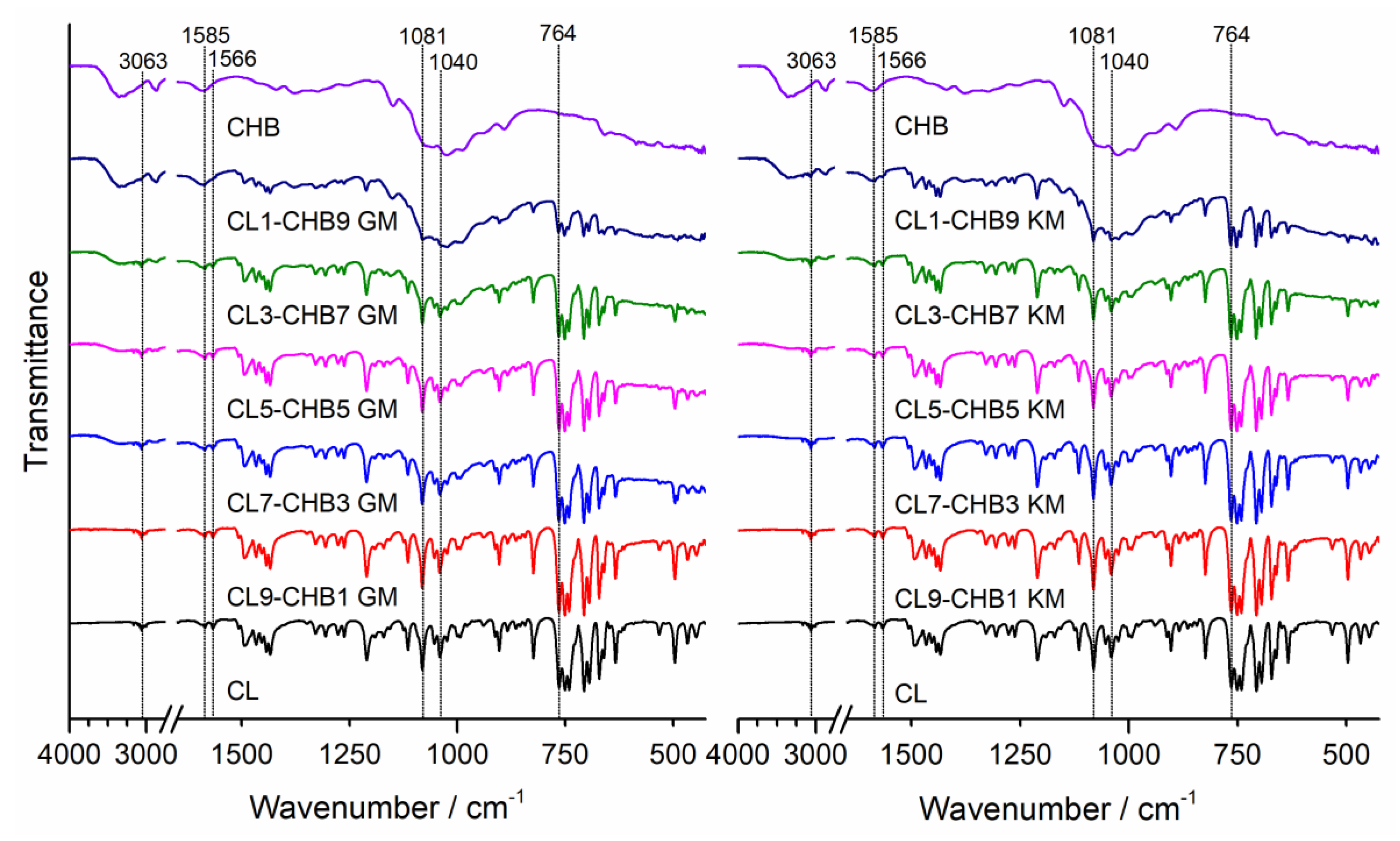
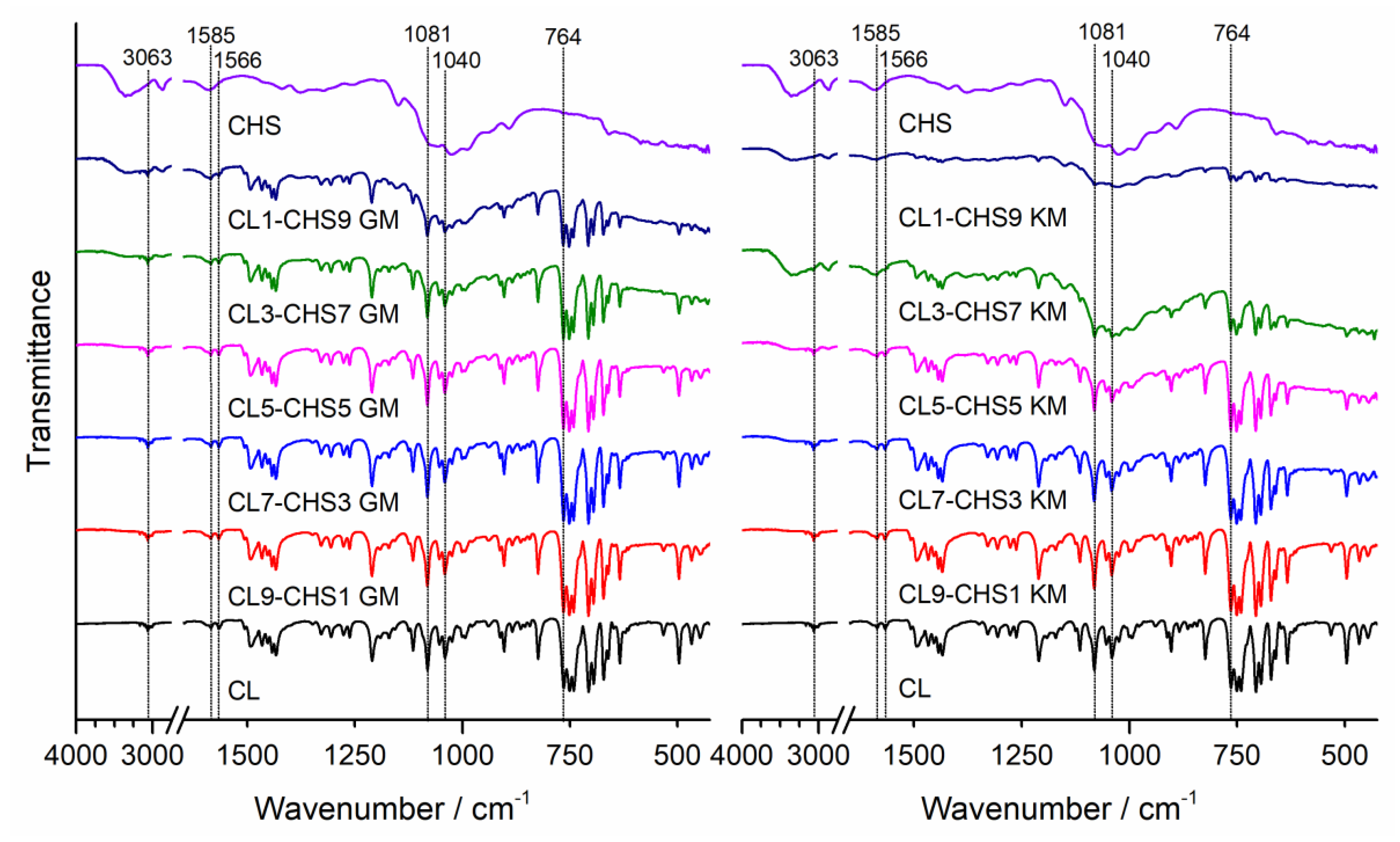
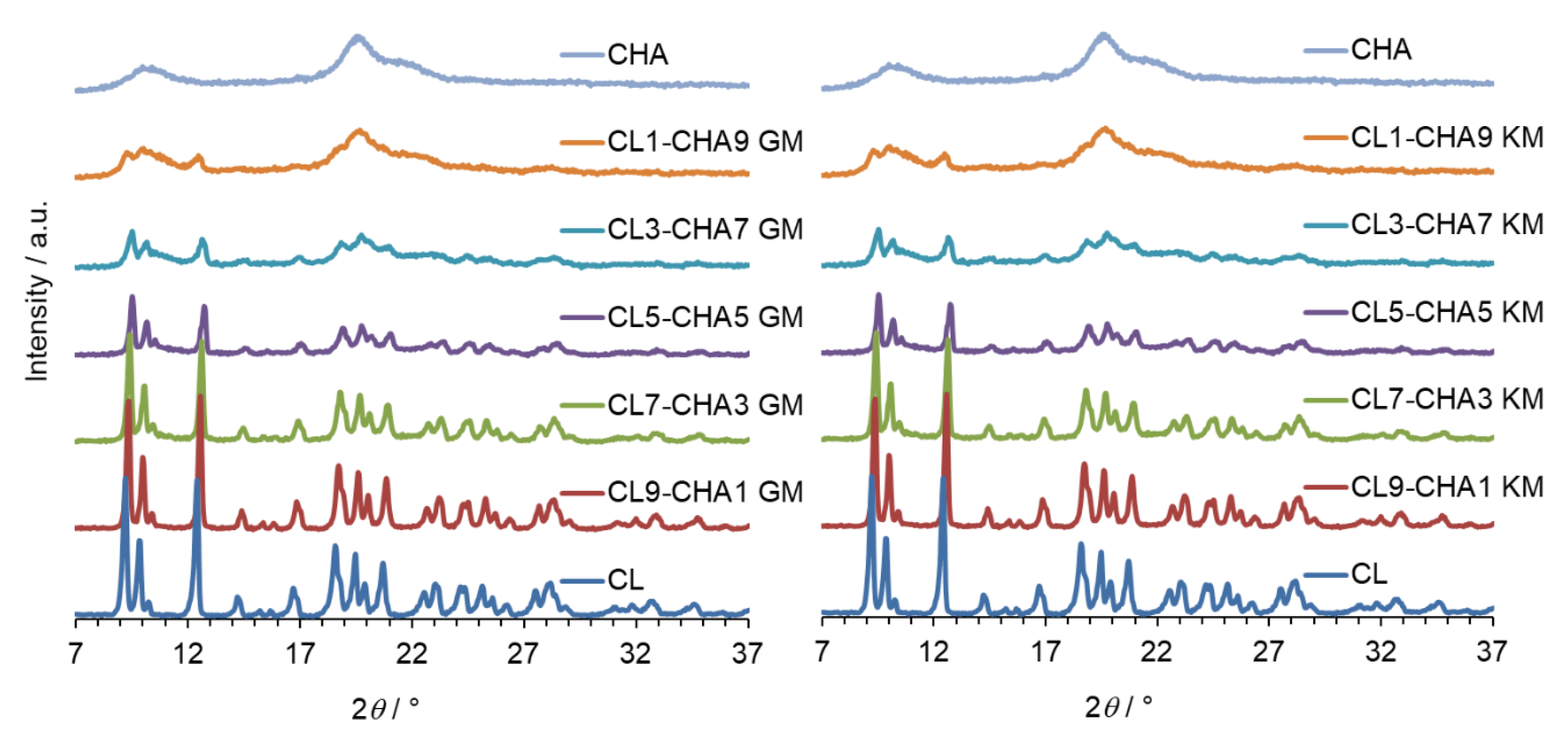
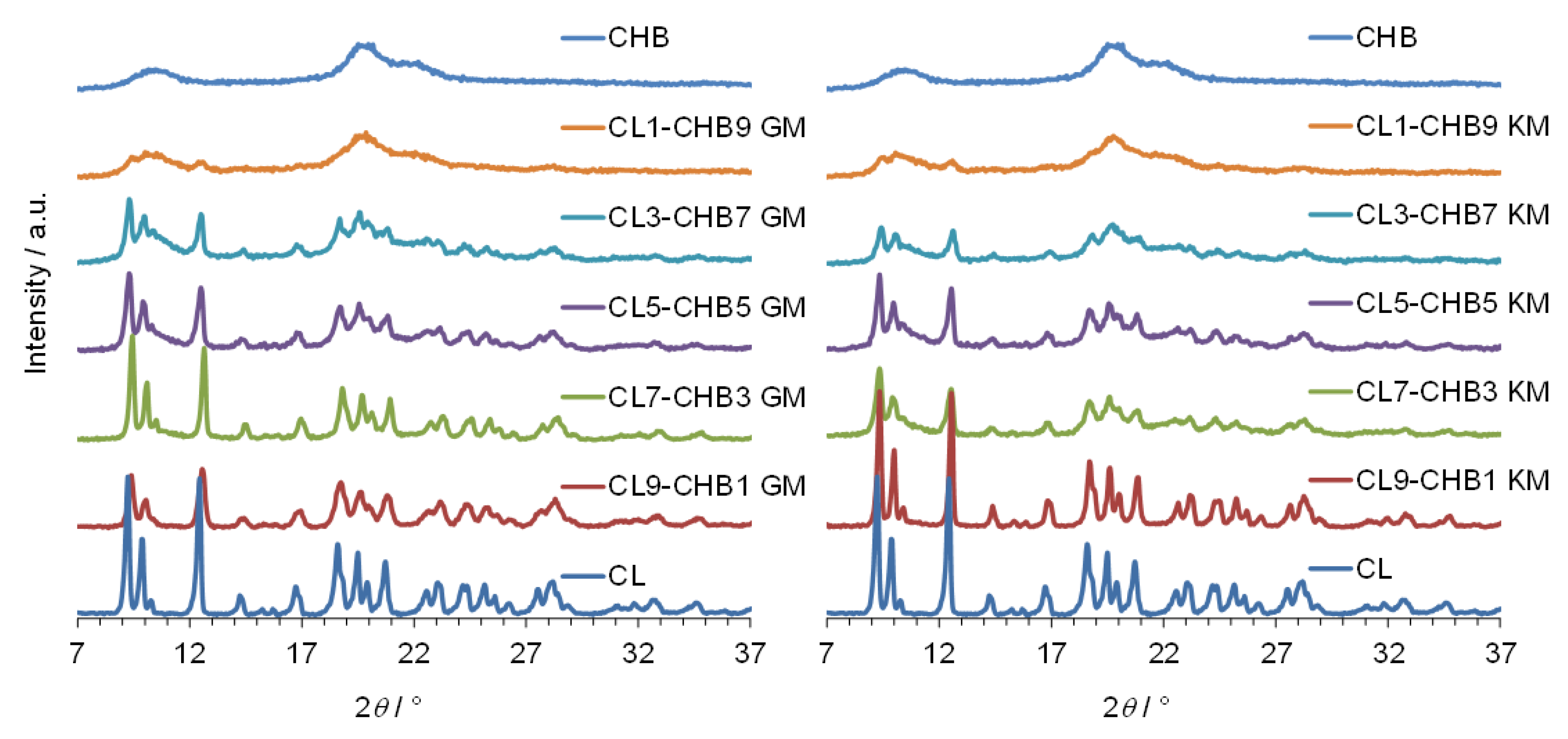

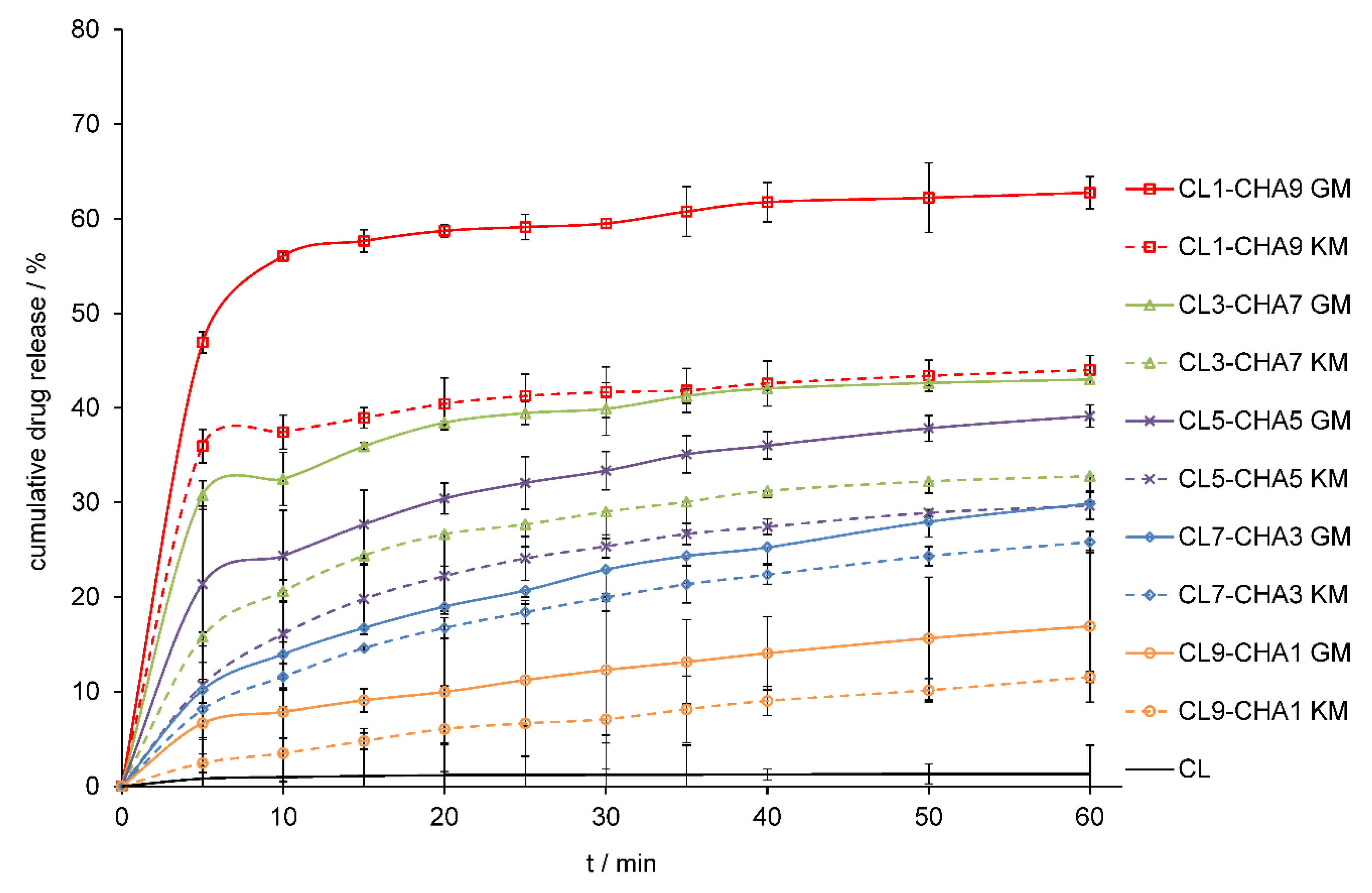

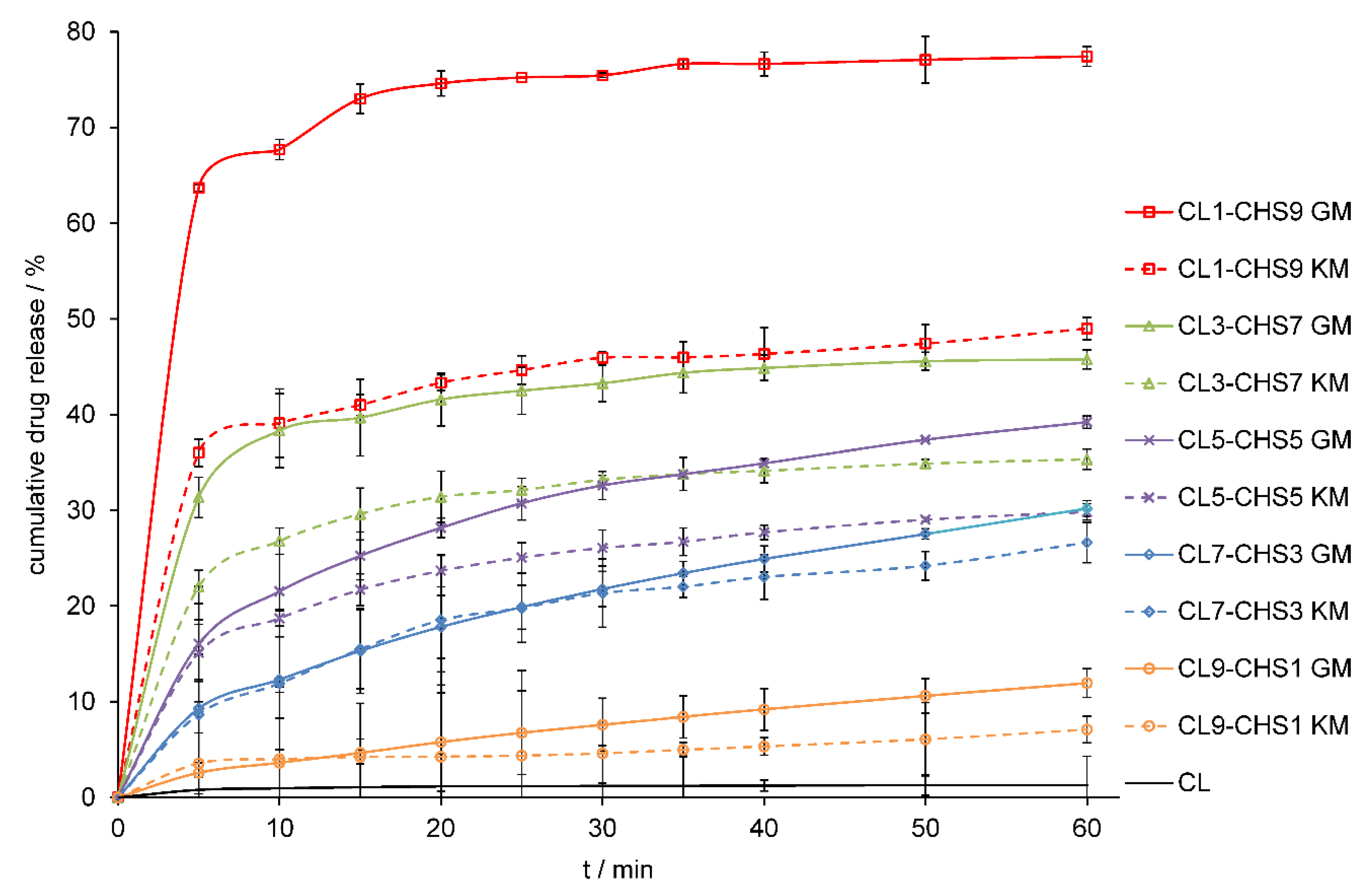
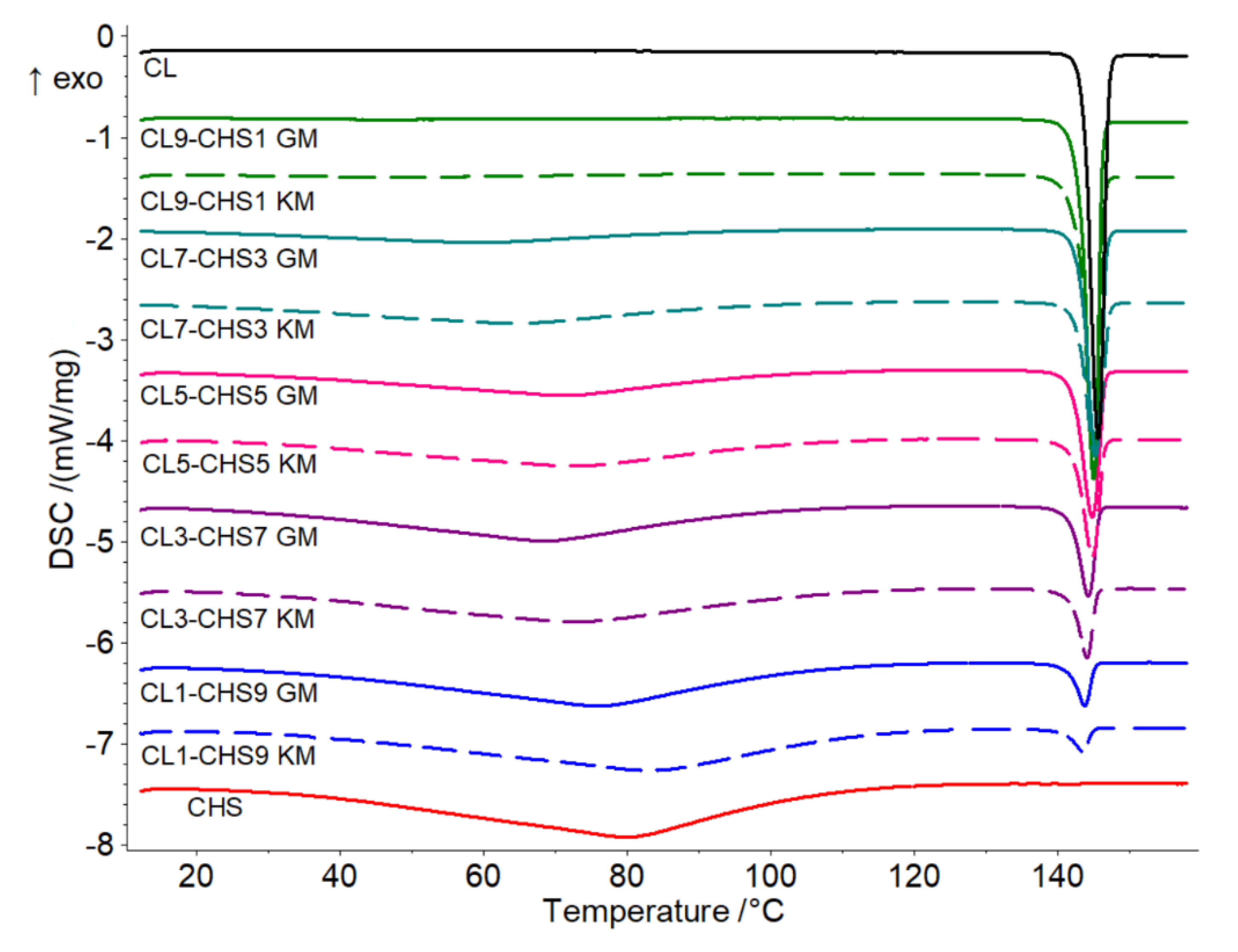
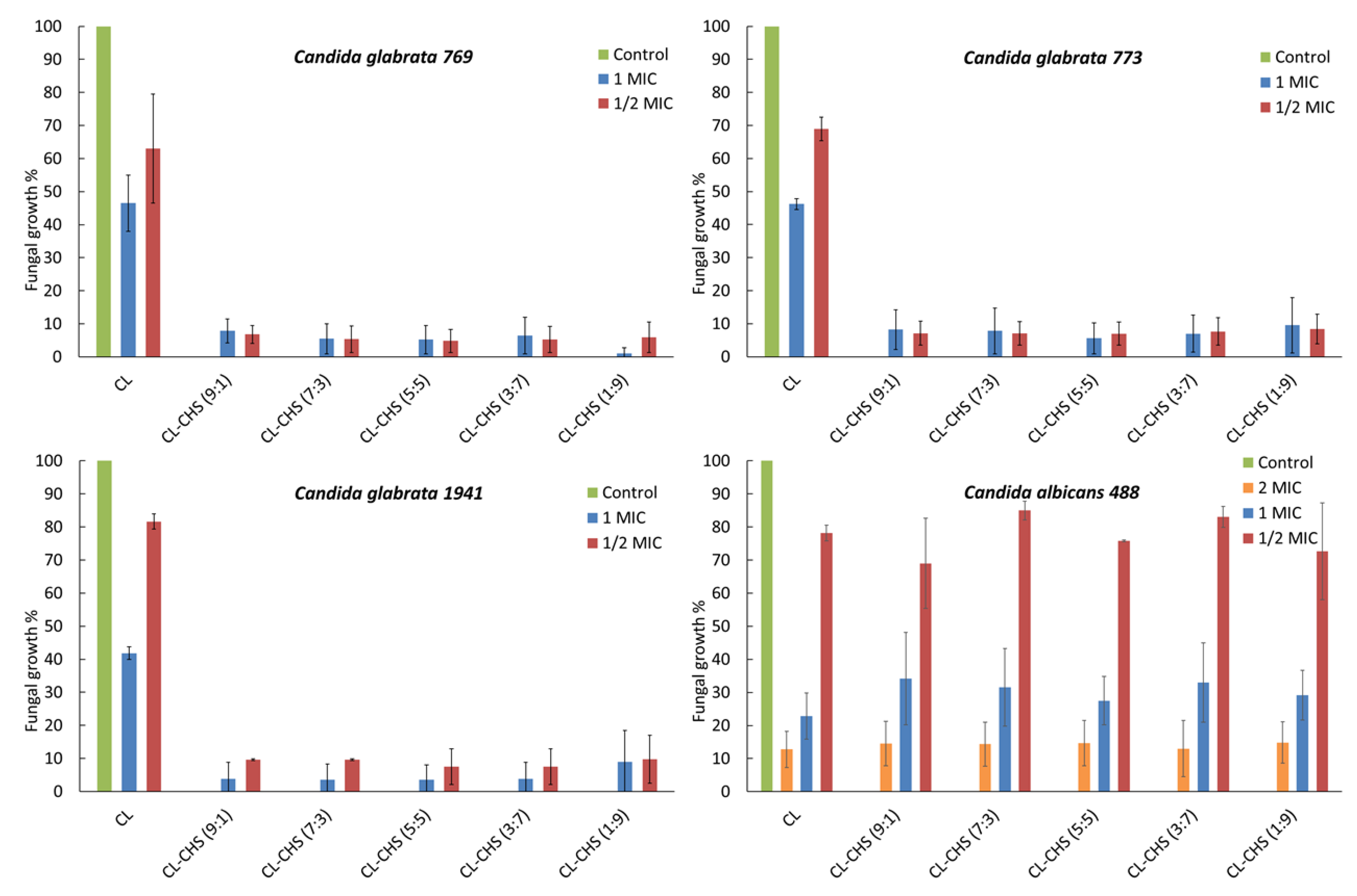
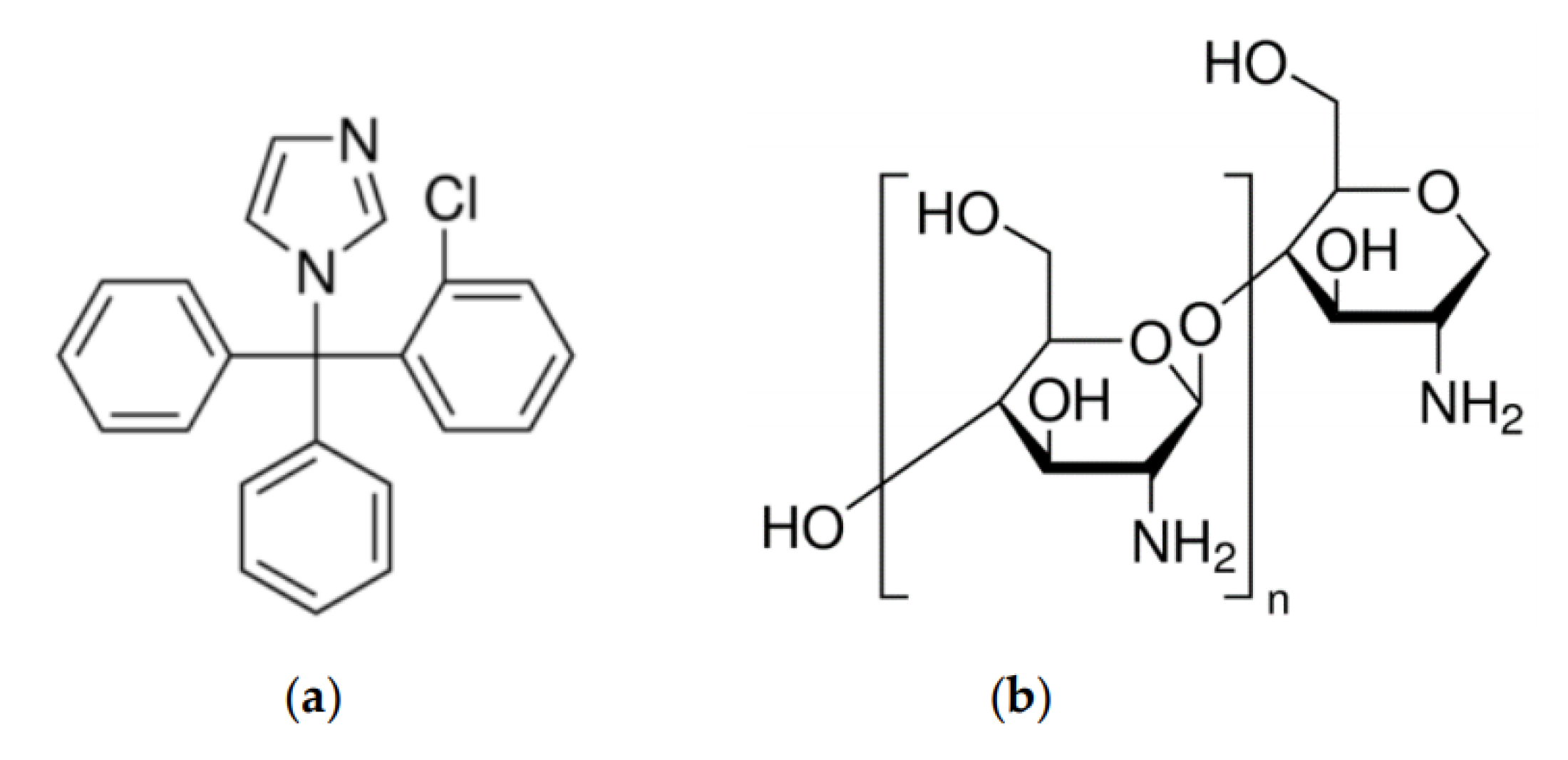
| Mixture Code | Drug/Chitosan Weight Ratio | ||
|---|---|---|---|
| Chitosan S | Chitosan A | Chitosan B | |
| grinding method (GM) | |||
| CL1-CHS9 GM | CL1-CHA9 GM | CL1-CHB9 GM | 1:9 |
| CL3-CHS7 GM | CL3-CHA7 GM | CL3-CHB7 GM | 3:7 |
| CL5-CHS5 GM | CL5-CHA5 GM | CL5-CHB5 GM | 5:5 |
| CL7-CHS3 GM | CL7-CHA3 GM | CL7-CHB3 GM | 7:3 |
| CL9-CHS1 GM | CL9-CHA1 GM | CL9-CHB1 GM | 9:1 |
| kneading method (KM) | |||
| CL1-CHS9 KM | CL1-CHA9 KM | CL1-CHB9 KM | 1:9 |
| CL3-CHS7 KM | CL3-CHA7 KM | CL3-CHB7 KM | 3:7 |
| CL5-CHS5 KM | CL5-CHA5 KM | CL5-CHB5 KM | 5:5 |
| CL7-CHS3 KM | CL7-CHA3 KM | CL7-CHB3 KM | 7:3 |
| CL9-CHS1 KM | CL9-CHA1 KM | CL9-CHB1 KM | 9:1 |
| Type of Formulation | % of Drug Release | Type of Formulation | % of Drug Release | Type of Formulation | % of Drug Release |
|---|---|---|---|---|---|
| Chitosan S | Chitosan A | Chitosan B | |||
| Grinding method | |||||
| CL1-CHS9 GM | 77.42 ± 1.03 | CL1-CHA9 GM | 62.77 ± 1.69 | CL1-CHB9 GM | 48.95 ± 0.99 |
| CL3-CHS7 GM | 45.77 ± 0.99 | CL3-CHA7 GM | 42.99 ± 0.50 | CL3-CHB7 GM | 39.52 ± 0.75 |
| CL5-CHS5 GM | 39.21 ± 0.64 | CL5-CHA5 GM | 39.14 ± 1.18 | CL5-CHB5 GM | 36.37 ± 1,17 |
| CL7-CHS3 GM | 30.20 ± 0.83 | CL7-CHA3 GM | 29.90 ± 1.73 | CL7-CHB3 GM | 26.98 ± 3.11 |
| CL9-CHS1 GM | 11.94 ± 1.50 | CL9-CHA1 GM | 16.91 ± 8.03 | CL9-CHB1 GM | 14.64 ± 6.82 |
| Kneading method | |||||
| CL1-CH9 KM | 48.99 ± 1.16 | CL1-CHA9 KM | 44.00 ± 1.54 | CL1-CHB9 KM | 43.84 ± 0.83 |
| CL3-CH7 KM | 35.34 ± 1.05 | CL3-CHA7 KM | 32.79 ± 1.57 | CL3-CHB7 KM | 30.62 ± 2.87 |
| CL5-CH5 KM | 29.84 ± 0.85 | CL5-CHA5 KM | 29.65 ± 1.43 | CL5-CHB5 KM | 28.87 ± 1.17 |
| CL7-CH3 KM | 26.64 ± 2.09 | CL7-CHA3 KM | 25.83 ± 1.13 | CL7-CHB3 KM | 21.96 ± 2.05 |
| CL9-CH1 KM | 7.11 ± 1.38 | CL9-CHA1 KM | 11.54 ± 0.56 | CL9-CHB1 KM | 11.00 ± 6.70 |
| Type of Formulation | ΔHfusion [J g−1] | Tpeak [°C] |
|---|---|---|
| Clotrimazole | 103.5 | 145.6 |
| CL9-CHS1 GM | 93.7 | 145.0 |
| CL9-CHS1 KM | 88.1 | 145.1 |
| CL5-CHS5 GM | 49.9 | 144.8 |
| CL5-CHS5 KM | 38.8 | 144.8 |
| CL3-CHS7 GM | 28.4 | 144.3 |
| CL3-CHS7 KM | 20.5 | 144.1 |
| CL1-CHS9 GM | 12.6 | 141.2 |
| CL1-CHS9 KM | 5.6 | 143.5 |
| Species | Strain Number | MICCL [mg/L] | MICCH [mg/L] | ||
|---|---|---|---|---|---|
| pH 7 | pH 4 | pH 7 | pH 4 | ||
| C. glabrata | ATCC 90030 | 0.125 | 3.9 | >250 | 3.9 |
| 769 | 4 | 31.2 | >250 | 3.9 | |
| 773 | 2 | 15.6 | >250 | >250 | |
| 1941 | 2 | 31.2 | >250 | 3.9 | |
| 2342 | 4 | 31.2 | >250 | >250 | |
| 2586 | 2 | 31.2 | >250 | 1.95 | |
| 2853 | 1 | 15.6 | >250 | >250 | |
| 2738 | 1 | 31.2 | >250 | >250 | |
| Mean ± SD for 8 strains | 2 ± 2.01 (1) | 22.8 ± 10.02 (1) | >250 (2) | 126.70 ± 123.20 (2) | |
| Median | 2.00 | 31.20 | >250 | 126.95 | |
| C. albicans | ATCC 90028 | <0.0156 | 0.03 | >250 | 7.8 |
| ATCC 10231 | <0.0156 | 0.06 | >250 | 15.6 | |
| 112 | <0.0078 | 0.06 | >250 | >250 | |
| 144 | <0.0078 | 0.0156 | >250 | >250 | |
| 177 | <0.0078 | 0.0156 | >250 | >250 | |
| 257 | <0.0078 | 0.0156 | >250 | >250 | |
| 259 | <0.0078 | 0.0156 | >250 | >250 | |
| 488 | 0.06 | 1 | >250 | >250 | |
| 1050 | 2 | 0.03 | >250 | >250 | |
| 1342 | 2 | 0.0156 | >250 | >250 | |
| 1444 | <0.0156 | 0.0156 | >250 | 0.8 | |
| 3089 | 0.06 | 0.25 | >250 | >250 | |
| Mean ± SD for 12 strains | 0.35 ± 0.74 (3) | 0.13 ± 0.27 (3) | >250 (4) | 189.51 ± 104.80 (4) | |
| Median | 0.0156 | 0.0228 | >250 | >250 | |
| Strain | Clotrimazole | Chitosan S | FICI (FICCL+FICCH) | ||||
|---|---|---|---|---|---|---|---|
| MICCL | MICCL-CH | FICCL (MICCL-CH /MICCL) | MICCH | MICCH-CL | FICCH (MICCH-CL /MICCH) | ||
| [mg/L] | [mg/L] | [mg/L] | [mg/L] | ||||
| C. glabrata 769 | 4 | 2 | 0.5 | >500 | <7.8 | 0.0156 | 0.5156 (IND) |
| C. glabrata 773 | 2 | 2 | 1 | >500 | <7.8 | 0.0156 | 1.0156 (IND) |
| C.glabrata 1941 | 2 | 2 | 1 | >500 | <7.8 | 0.0156 | 1.0156 (IND) |
| C.albicans 488 | 0.06 | 0.06 | 1 | >500 | <7.8 | 0.0156 | 1.0156 (IND) |
| Strain | Clotrimazole | Chitosan S | FICI (FICCL+FICCH) | ||||
|---|---|---|---|---|---|---|---|
| MICCL | MICCL-CH | FICCL (MICCL-CH /MICCL) | MICCH | MICCH-CL | FICCH (MICCH-CL /MICCH) | ||
| [mg/L] | [mg/L] | [mg/L] | [mg/L] | ||||
| C.glabrata 769 | 31.25 | <0.25 | 0.008 | 3.9 | <0.25 | 0.0640 | 0.0720 (SYN) |
| C.glabrata 773 | 15.60 | 1 | 0.064 | >500 | <7.8 | 0.0156 | 0.0796 (SYN) |
| C.glabrata 1941 | 31.25 | <0.25 | 0.008 | 3.9 | 1 | 0.2564 | 0.2644 (SYN) |
| C.albicans 488 | 1 | 1 | 1 | >500 | <7.8 | 1.0156 | 1.0312 (IND) |
| Chitosan Sample | Intrinsic Viscosity (η) 1 [dm3 /g] | Viscosity-Average Molecular Weight (Mv) 2 [kDa] |
|---|---|---|
| chitosan S | 0.7437 | 1087 |
| chitosan A | 0.5843 | 839 |
| chitosan B | 0.2986 | 407 |
Publisher’s Note: MDPI stays neutral with regard to jurisdictional claims in published maps and institutional affiliations. |
© 2020 by the authors. Licensee MDPI, Basel, Switzerland. This article is an open access article distributed under the terms and conditions of the Creative Commons Attribution (CC BY) license (http://creativecommons.org/licenses/by/4.0/).
Share and Cite
Grimling, B.; Karolewicz, B.; Nawrot, U.; Włodarczyk, K.; Górniak, A. Physicochemical and Antifungal Properties of Clotrimazole in Combination with High-Molecular Weight Chitosan as a Multifunctional Excipient. Mar. Drugs 2020, 18, 591. https://doi.org/10.3390/md18120591
Grimling B, Karolewicz B, Nawrot U, Włodarczyk K, Górniak A. Physicochemical and Antifungal Properties of Clotrimazole in Combination with High-Molecular Weight Chitosan as a Multifunctional Excipient. Marine Drugs. 2020; 18(12):591. https://doi.org/10.3390/md18120591
Chicago/Turabian StyleGrimling, Bożena, Bożena Karolewicz, Urszula Nawrot, Katarzyna Włodarczyk, and Agata Górniak. 2020. "Physicochemical and Antifungal Properties of Clotrimazole in Combination with High-Molecular Weight Chitosan as a Multifunctional Excipient" Marine Drugs 18, no. 12: 591. https://doi.org/10.3390/md18120591
APA StyleGrimling, B., Karolewicz, B., Nawrot, U., Włodarczyk, K., & Górniak, A. (2020). Physicochemical and Antifungal Properties of Clotrimazole in Combination with High-Molecular Weight Chitosan as a Multifunctional Excipient. Marine Drugs, 18(12), 591. https://doi.org/10.3390/md18120591






